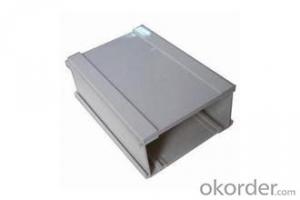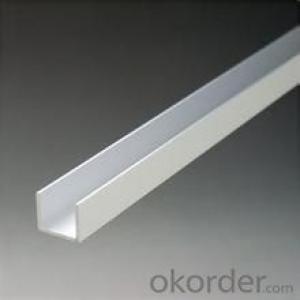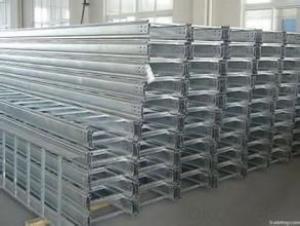Aluminum Section H cable tray
- Loading Port:
- China Main Port
- Payment Terms:
- TT OR LC
- Min Order Qty:
- -
- Supply Capability:
- -
OKorder Service Pledge
OKorder Financial Service
You Might Also Like
Aluminium is a relatively soft,durable, lightweight, ductile and malleablemetal with appearance ranging from silvery to dull gray,depending on the surface roughness. It is nonmagnetic and does not easilyignite. A fresh film of aluminium serves as a good reflector (approximately92%) of visible light and an excellent reflector (as much as98%) of medium and far infrared radiation. The yield strength of pure aluminium is 7–11 MPa,while aluminium alloys have yield strengths ranging from200 MPa to 600 MPa. Aluminium has about one-third the density and stiffnessof steel. It iseasily machined,cast, drawn and extruded.
Alu Profile:
Material | Alloy 6063,6061,6005or according to customer’s choice |
Temper | T3, T4, T5, T6 |
Surface | Anodize, electrophoresis, powder coating, PVDF coating, wood grain painting, matted, etc. |
Length | Coating 6.5 meters, Anodizing 6.5 meters, Mill finish 5 meters |
Application | Industrial, electrical equipment(TV set, air conditioner, refrigerator, computer), decoration,construction, transportation |
Custom Made | We can package following with customer's request. |
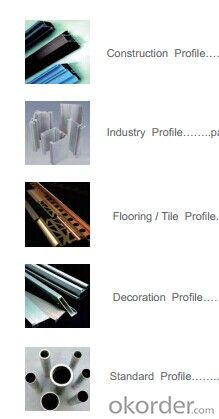
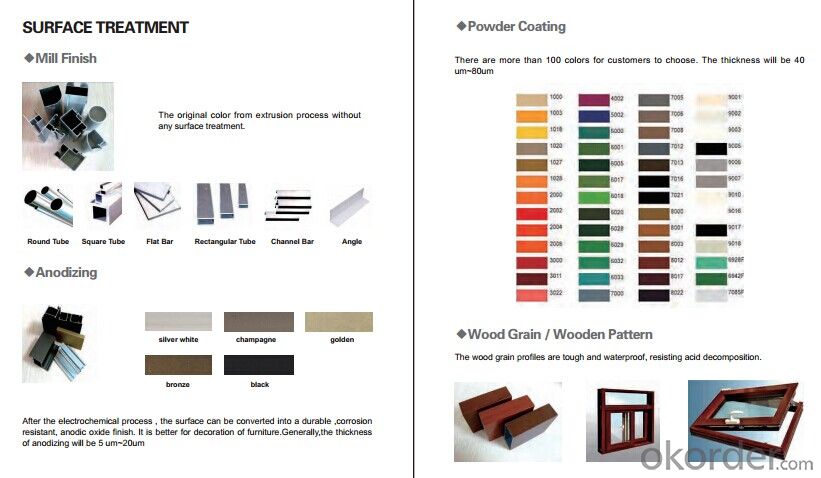

FAQ:
1. What is the form of payment?
Normally 30% TT, L/C at sight
2. Type of quotation?
FOB, CFR, CIF
3. Port of loading?
Guangzhou/Shenzhen port
4. Delivery time?
15-20 days after client’s deposit
- Q:How do you ensure proper insulation with aluminum profiles?
- To ensure proper insulation with aluminum profiles, there are several key steps that can be taken. 1. Thermal break technology: Utilize aluminum profiles with thermal break technology. This involves the addition of a non-conductive material, such as polyamide, between the inner and outer aluminum sections. This helps to reduce heat transfer and improve insulation properties. 2. Proper sealing: Ensure that the aluminum profiles are properly sealed when installed. This includes using high-quality sealants and gaskets to prevent air leakage and create a tight seal. Pay attention to corners, joints, and any other potential areas of air infiltration. 3. Double or triple glazing: When using aluminum profiles for windows or doors, opt for double or triple glazing. This involves using multiple layers of glass with an air or gas-filled space in between. This extra layer of insulation helps to reduce heat transfer and improve energy efficiency. 4. Insulated frames: Consider using aluminum profiles with insulated frames. These frames have a layer of insulation material within them, further reducing heat transfer and improving thermal performance. 5. Thermal insulation accessories: Utilize additional thermal insulation accessories, such as thermal breaks, insulation tapes, or foam inserts. These can be installed within the aluminum profiles to enhance insulation properties and minimize thermal bridging. 6. Proper installation techniques: Ensure that the aluminum profiles are installed correctly by following manufacturer guidelines and recommendations. This includes using appropriate fasteners, avoiding gaps or spaces, and ensuring proper alignment and fit. By implementing these measures, proper insulation can be achieved with aluminum profiles, resulting in improved energy efficiency, reduced heat loss or gain, and increased comfort in buildings.
- Q:Are aluminum profiles recyclable?
- Yes, aluminum profiles are recyclable. Aluminum is one of the most sustainable and widely recycled materials in the world. It can be recycled repeatedly without losing its quality, making it an environmentally friendly choice for various applications, including profiles.
- Q:How do you install aluminum profiles?
- To install aluminum profiles, first, determine the appropriate location and measurements for the profiles. Then, using a saw or cutter, cut the profiles to the desired length. Next, attach the profiles to the designated area using screws or brackets. Ensure that the profiles are securely fastened. Finally, make any necessary adjustments or modifications to achieve the desired fit and appearance.
- Q:Can aluminum profiles be used in the construction of retail displays?
- Yes, retail displays can utilize aluminum profiles in their construction. Aluminum is a versatile and lightweight material that finds common application in various industries, such as construction and retail. It provides several benefits for retail displays, including durability, resistance to corrosion, and ease of customization. Aluminum profiles can be effortlessly shaped and fabricated to create diverse types of retail displays like shelving units, display stands, signage frames, and product showcases. These profiles can be extruded into different shapes and sizes, enabling flexibility in design and functionality. Moreover, aluminum profiles can undergo various surface treatments, such as anodizing or powder coating, to enhance their appearance and offer a protective layer against scratches and wear. This ensures that retail displays can maintain their aesthetic appeal and withstand the demands of a retail setting. Furthermore, aluminum is an eco-friendly material due to its high recyclability, making it an environmentally conscious choice for retail displays. It can be easily recycled without losing its properties, thus reducing the environmental impact of the construction and retail industries. To summarize, aluminum profiles are a practical and appropriate option for constructing retail displays. They provide durability, versatility, and customization possibilities while being lightweight and environmentally friendly.
- Q:What are the load-bearing capacities of different aluminum profile shapes?
- The load-bearing capacities of different aluminum profile shapes vary depending on various factors such as the specific alloy of aluminum used, the size and dimensions of the profile, and the specific application or use case. Aluminum profiles, also known as extrusions, come in a wide range of shapes including I-beams, T-beams, square tubes, rectangular tubes, angles, and channels. Each profile shape has its own unique load-bearing capacity due to its structural design and cross-sectional properties. For example, I-beams are known for their high load-bearing capacity due to their shape, which allows for efficient weight distribution along the flanges. They are commonly used in structural applications where heavy loads need to be supported. T-beams, on the other hand, have a load-bearing capacity similar to I-beams but with a different cross-sectional shape. They are often used in applications where a flat surface is required on one side, such as in construction or automotive industries. Square and rectangular tubes are versatile profiles that are often used in building structures, frames, and support systems. Their load-bearing capacity depends on the wall thickness and size of the tube. Angles and channels, which have a L-shaped and U-shaped cross-section respectively, are commonly used in construction and manufacturing industries. Their load-bearing capacity depends on the size and dimensions of the profile. It is important to note that the load-bearing capacities of aluminum profiles are typically provided by the manufacturer and should be consulted for specific applications. Additionally, engineering calculations and considerations such as deflection, bending moments, and safety factors should be taken into account when determining the appropriate aluminum profile shape and size for a given load-bearing requirement.
- Q:What are the dimensions and sizes of aluminum profiles?
- The dimensions and sizes of aluminum profiles can vary greatly depending on their intended use and design. They can range from small and narrow profiles, such as 10mm x 10mm square tubes, to larger and wider profiles, such as 100mm x 100mm square tubes. Additionally, aluminum profiles can come in various shapes, including square, rectangular, round, and custom shapes, to accommodate different applications and structural requirements. It is important to consult specific product catalogs or manufacturers for precise dimensions and sizes of aluminum profiles.
- Q:I do aluminum sales, never been to Chongqing, want to sell the aluminum section of the building materials market to see, please say specific name and address, convenient for me to go, thank you!There must be aluminum material concentration distribution market, thank you!
- The city's building materials, base more than 70% of the sales in majiayan. But the furniture industry has become a major shortage of the traditional building materials market, which has become a major mishap of majiayan building materials market. Resulting in the entire building materials, home industry chain slightly inadequate.
- Q:What do you mean by "80868 fingers" of aluminum alloy door and window?
- Model bar, just like stainless steel 304, which is defined as the amount of metal.
- Q:Are aluminum profiles easy to install?
- Yes, aluminum profiles are generally easy to install. They are lightweight and can be easily manipulated, making the installation process simpler compared to other materials. Additionally, aluminum profiles often come with pre-drilled holes or slots, which facilitate the installation and ensure accurate alignment. Furthermore, aluminum profiles usually feature a modular design, allowing for easy assembly and disassembly without the need for specialized tools or skills. Overall, the user-friendly nature of aluminum profiles makes them a popular choice for various applications, including construction, manufacturing, and DIY projects.
- Q:What are the different bending radii available for aluminum profiles?
- Depending on the specific application requirements, the available bending radii for aluminum profiles can vary. However, aluminum profiles typically offer a range of bending radii options to accommodate different needs. Common bending radii for aluminum profiles include 1.5D, 2D, 3D, and 4D. In these radii, the "D" refers to the outer diameter of the profile. For instance, a 1.5D bending radius indicates that the bend radius is 1.5 times the outer diameter of the profile. The choice of bending radius depends on various factors, such as the thickness and alloy of the aluminum, the desired bending angle, and the intended application. Smaller bending radii are often employed for tighter bends or when a more compact design is necessary. Conversely, larger bending radii are suitable for gentler bends or when maintaining the structural integrity of the profile is crucial. It is important to note that the bending process can impact the mechanical properties of the aluminum profile, including its strength and stiffness. Therefore, it is crucial to carefully consider the bending radius to ensure that the profile retains its desired properties post-bending. To determine the most appropriate bending radius for a specific aluminum profile, it is advisable to seek guidance from manufacturers or experts knowledgeable in aluminum bending processes. They can offer valuable insights based on the specific requirements and limitations of the application.
1. Manufacturer Overview |
|
|---|---|
| Location | |
| Year Established | |
| Annual Output Value | |
| Main Markets | |
| Company Certifications | |
2. Manufacturer Certificates |
|
|---|---|
| a) Certification Name | |
| Range | |
| Reference | |
| Validity Period | |
3. Manufacturer Capability |
|
|---|---|
| a)Trade Capacity | |
| Nearest Port | |
| Export Percentage | |
| No.of Employees in Trade Department | |
| Language Spoken: | |
| b)Factory Information | |
| Factory Size: | |
| No. of Production Lines | |
| Contract Manufacturing | |
| Product Price Range | |
Send your message to us
Aluminum Section H cable tray
- Loading Port:
- China Main Port
- Payment Terms:
- TT OR LC
- Min Order Qty:
- -
- Supply Capability:
- -
OKorder Service Pledge
OKorder Financial Service
Similar products
New products
Hot products
Hot Searches
Related keywords
